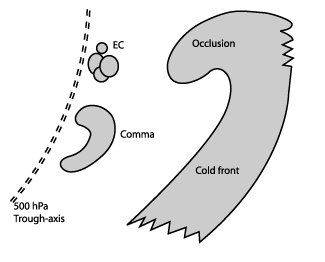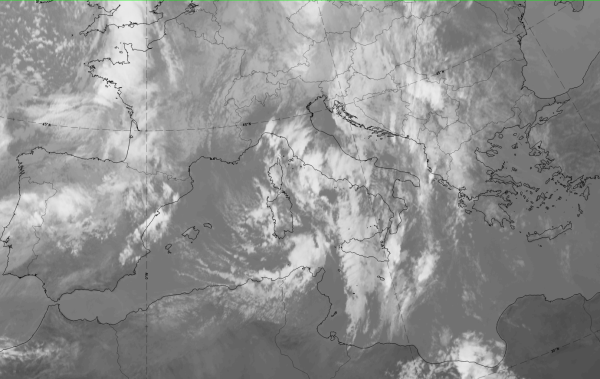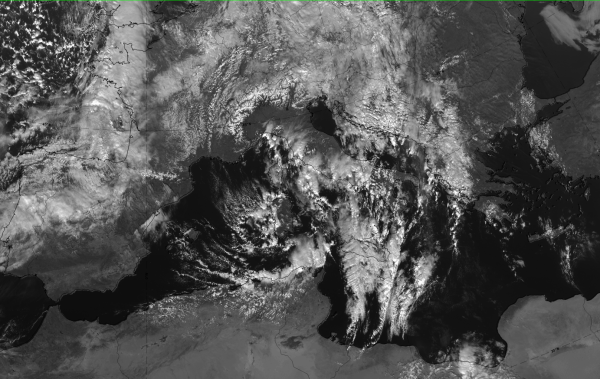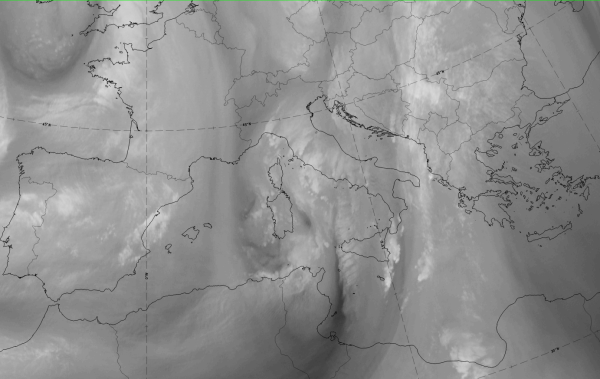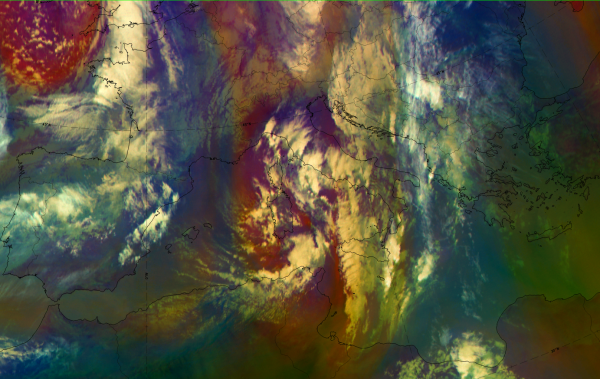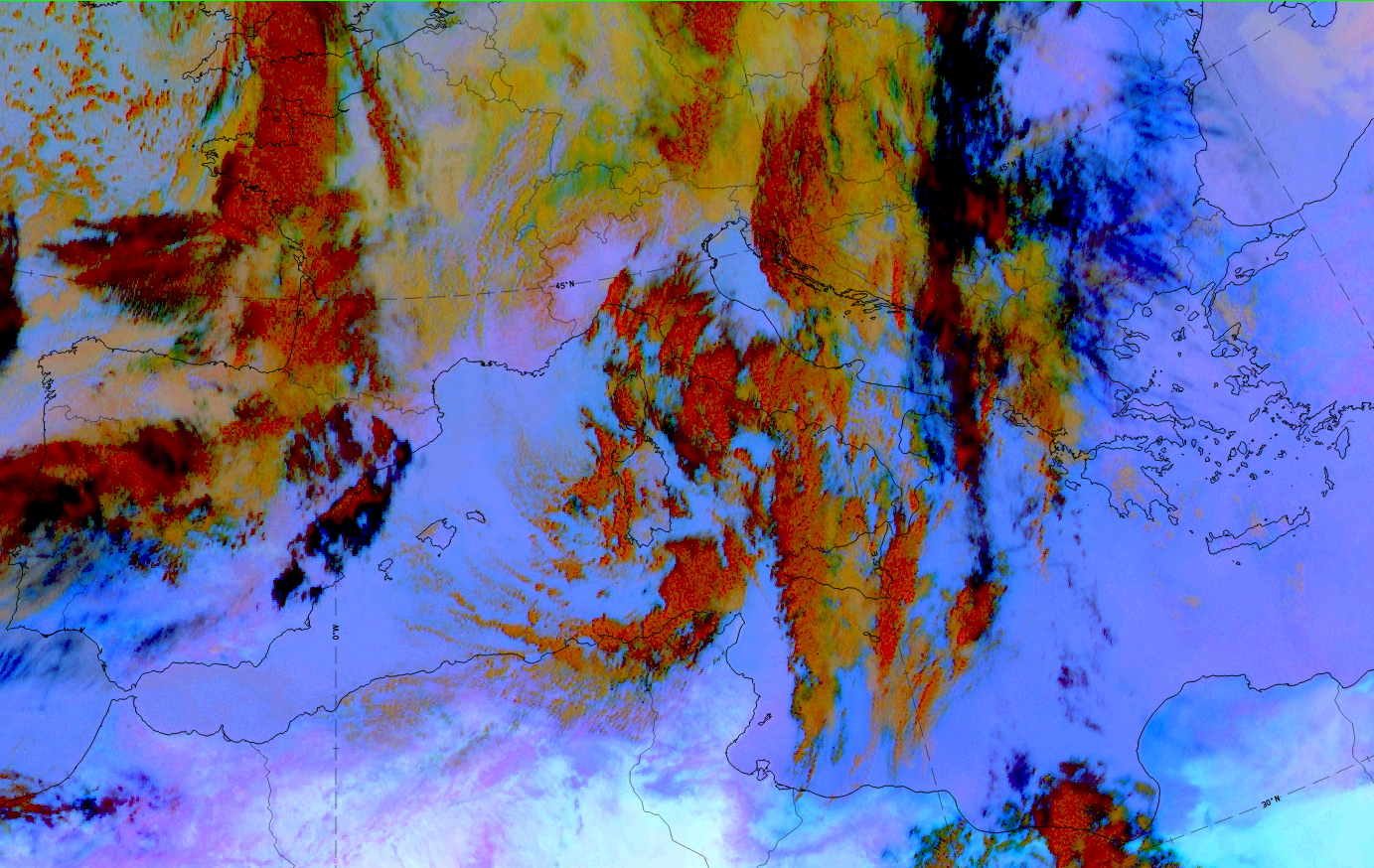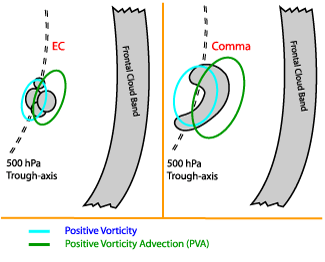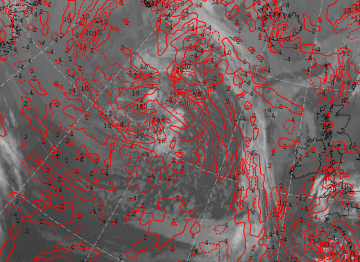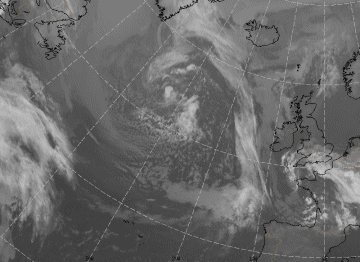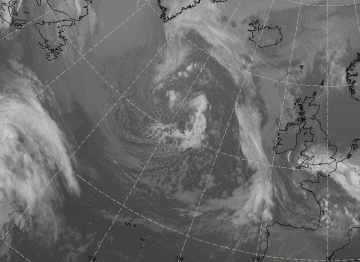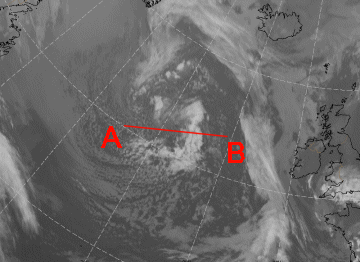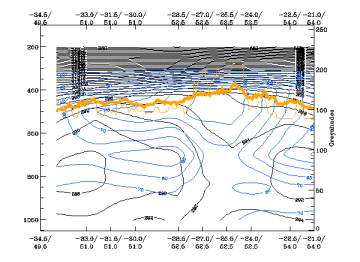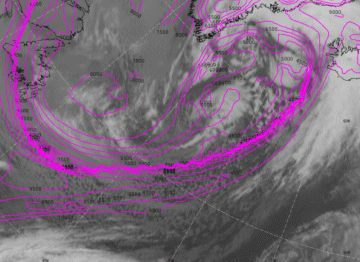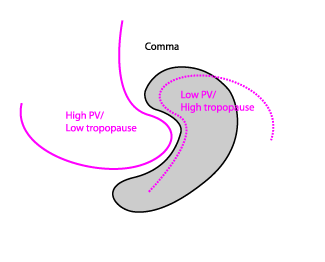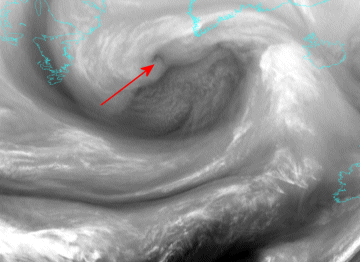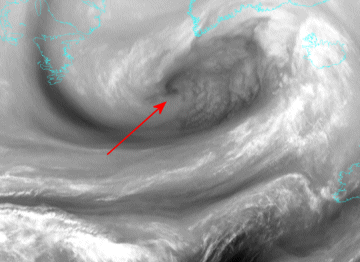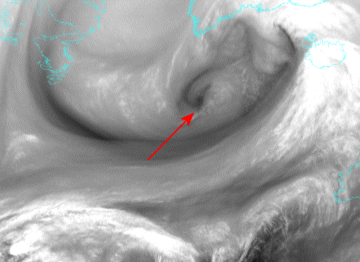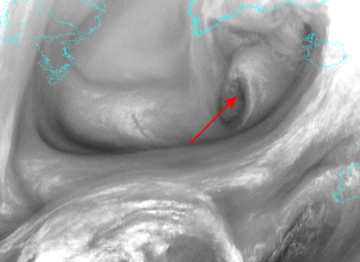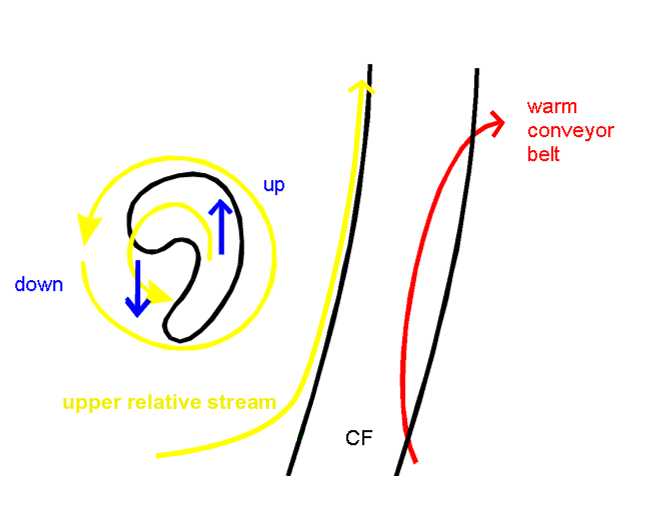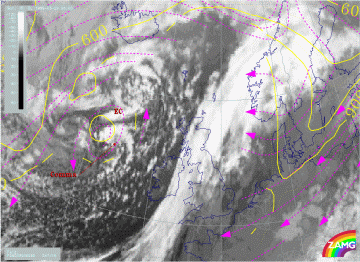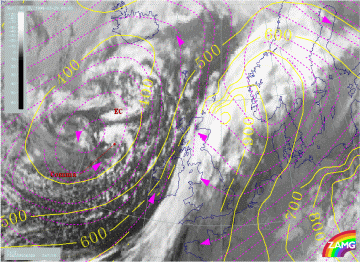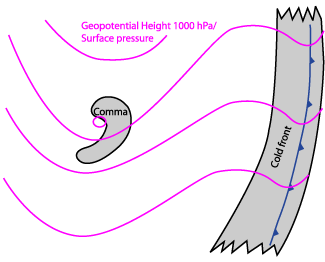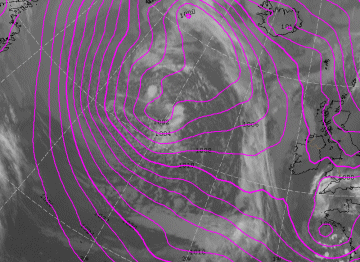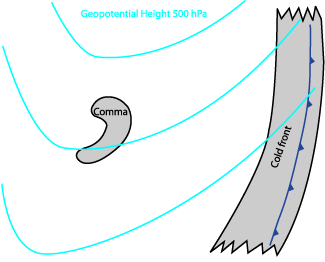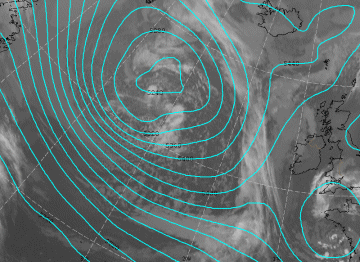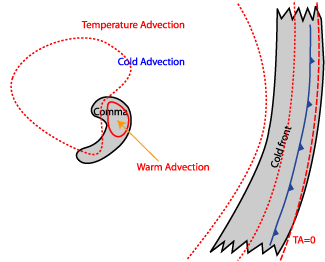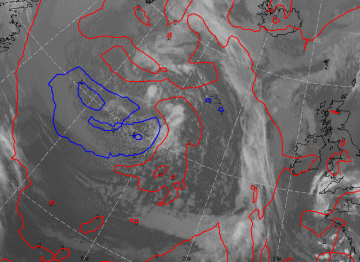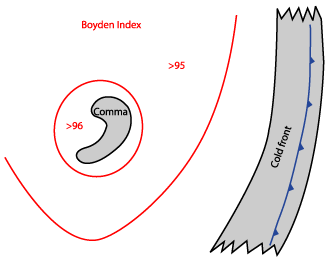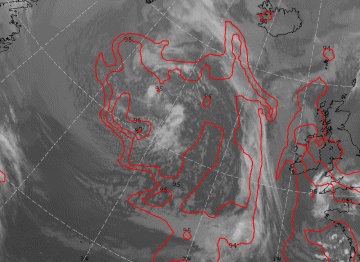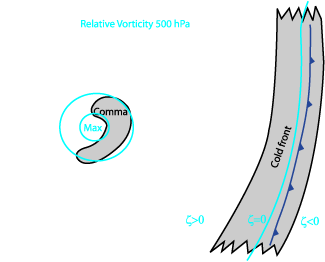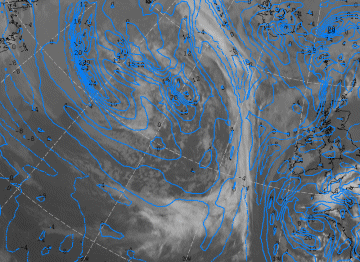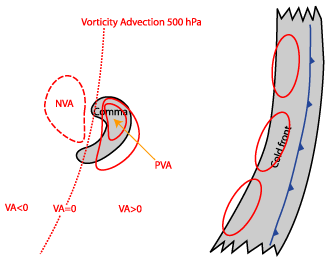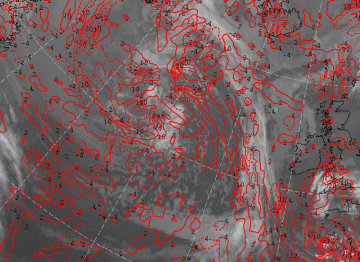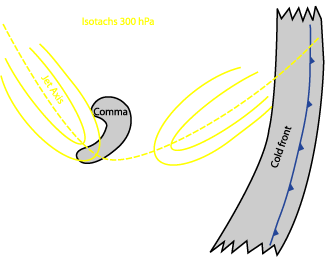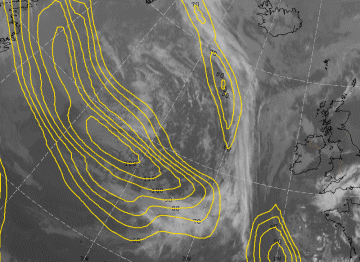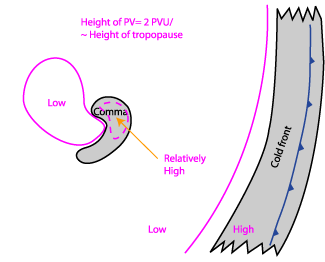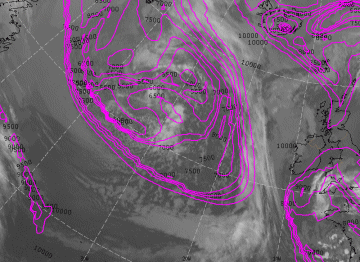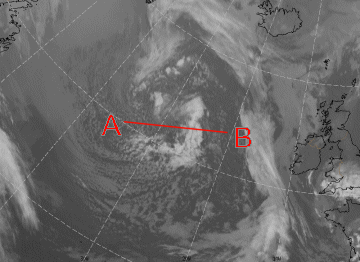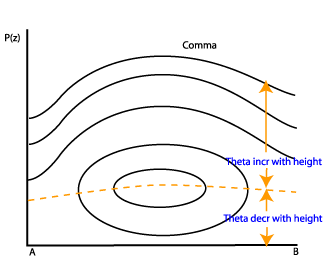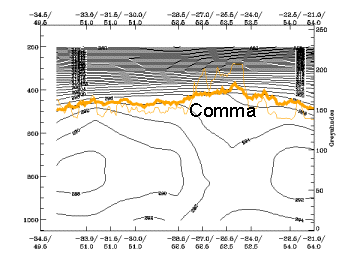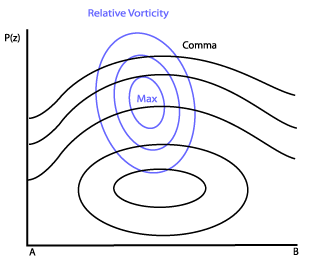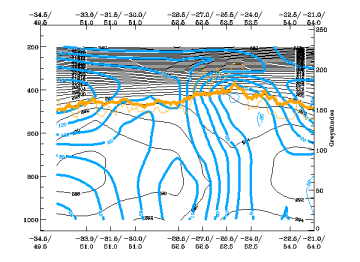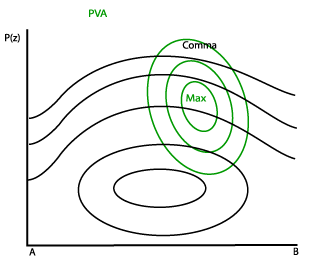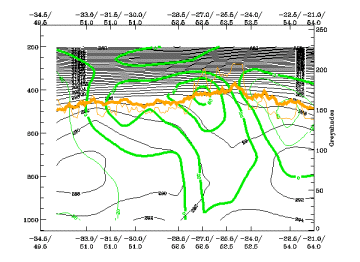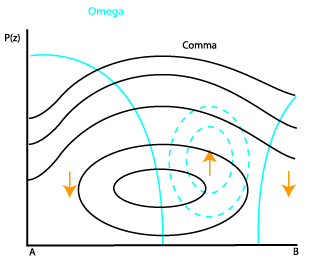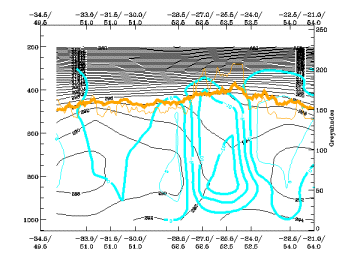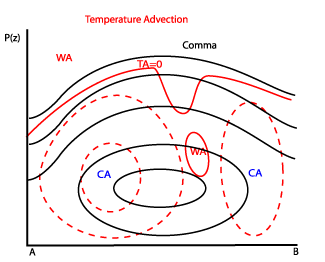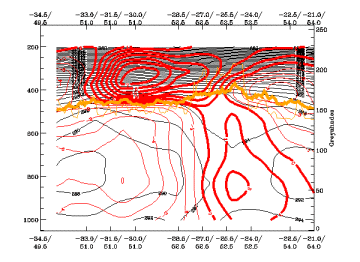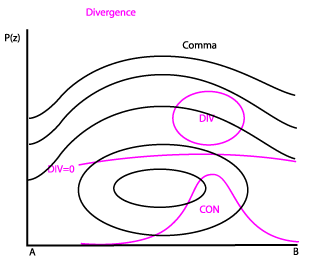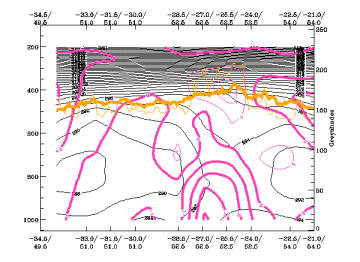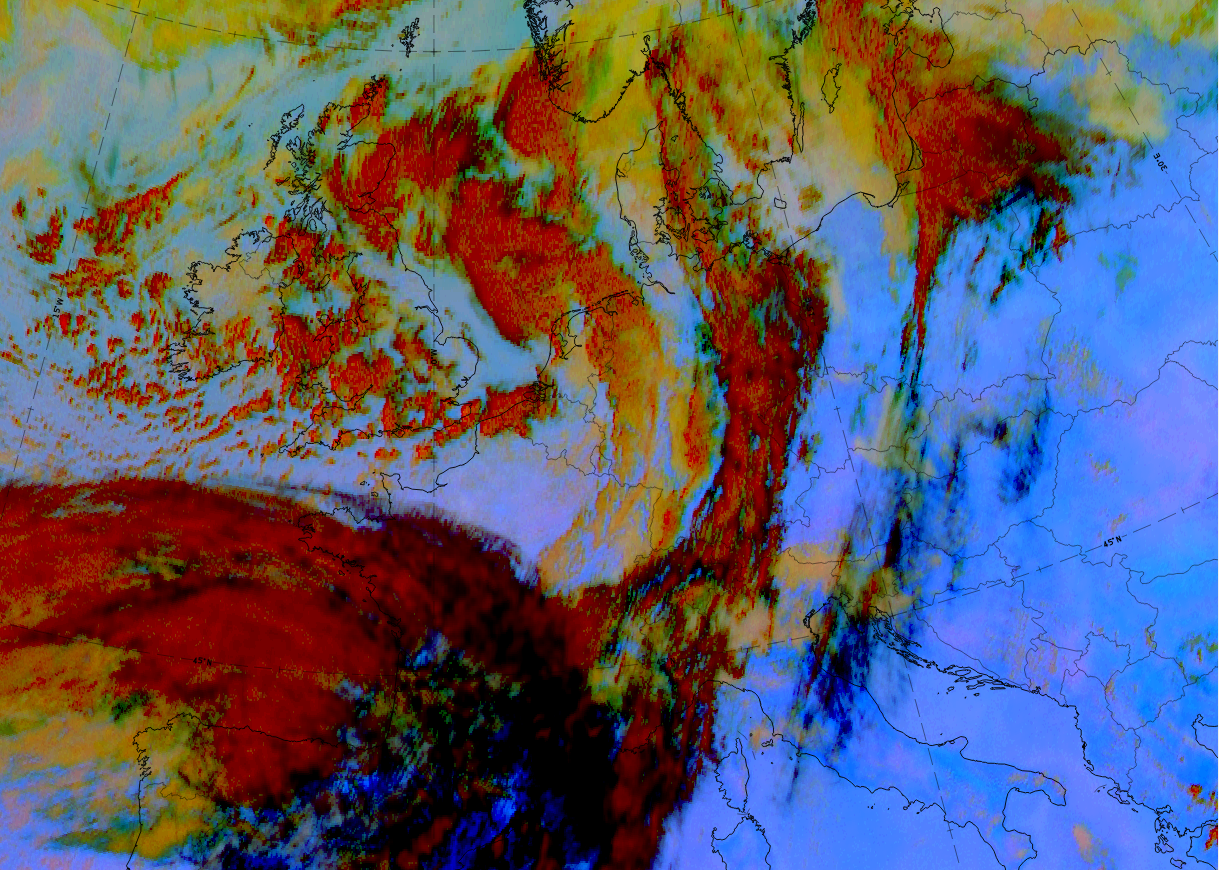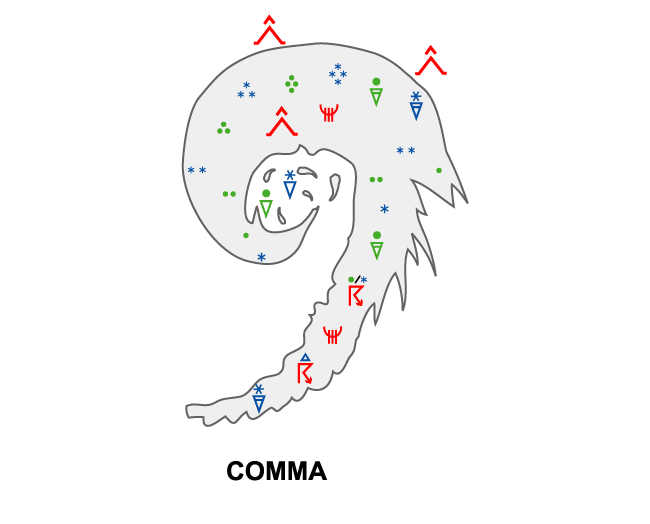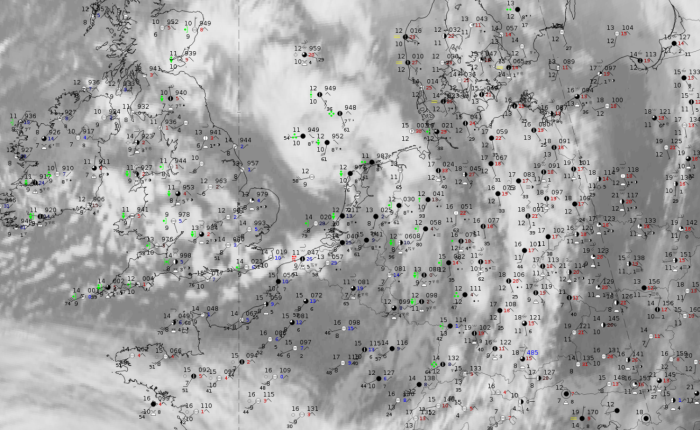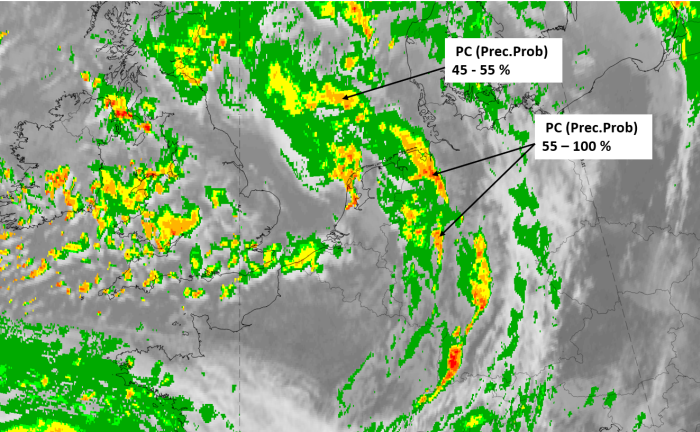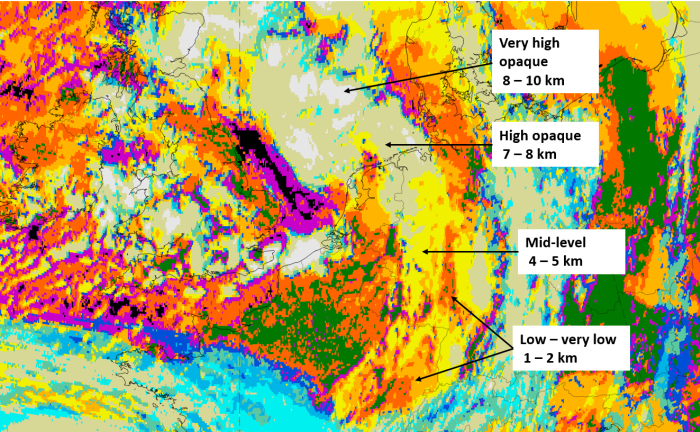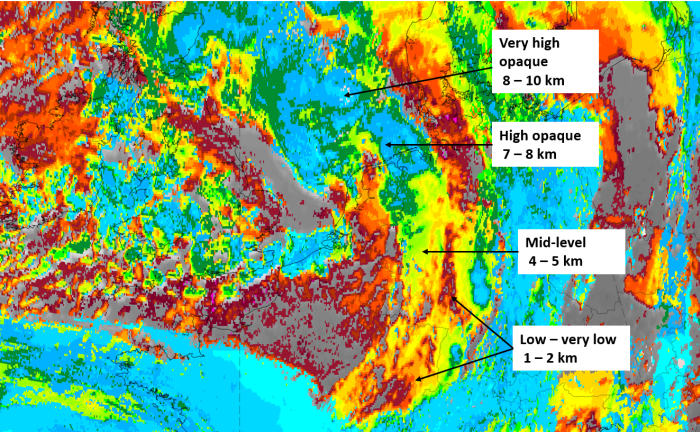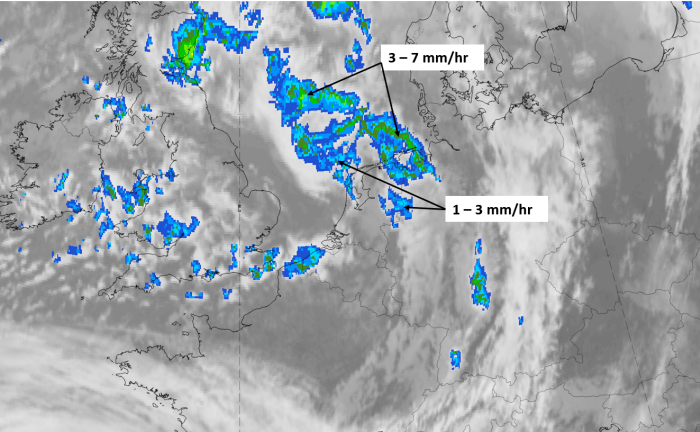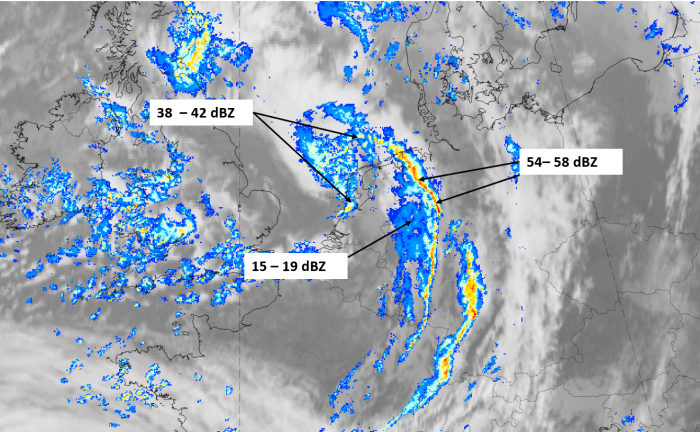Table of Contents
Cloud Structure In Satellite Images
A Comma is a very prominent cloud feature that develops and exists in cold air. Several similar phenomena occur within cold air, such as Enhanced Cumulus cloudiness (see Enhanced Cumulus). Also found in cold air are vortex rings, crescents, ovals, solid cloudiness, multiple deep or shallow bands, single deep or shallow bands and swirls in cumulus streets.
In order to distinguish the Comma from other cold air features, the Comma cloudiness is defined as a small to meso-scale cloud spiral consisting of white (i.e., cold) cloud cells partly overlaid by cirrus shields. In most cases the strongest convection can be found in the Comma tail, but sometimes enhanced convection can also be found in the Comma head. In a few cases the Comma head and tail are separated by a narrow cloud-free area or only connected by low clouds (although this may not be apparent throughout the whole lifetime of the system). Commas occur on scales between 200 and 1000 km, i.e., much smaller than a fully developed depression or a cyclone.
Larger Commas can be a sign of a development process called Cold Air Development (see Cold Air Development), where a Comma increases in size and finally gains some frontal characteristics.
Appearance in the basic channels
Comma head:
IR, VIS, WV: white, especially in the areas of embedded convection, representing rather thick cloud.
Comma tail:
IR, VIS and WV: light grey changing to white in the areas of convection. This represents lower cloud tops than on the head, where convection reaches higher of it exists.
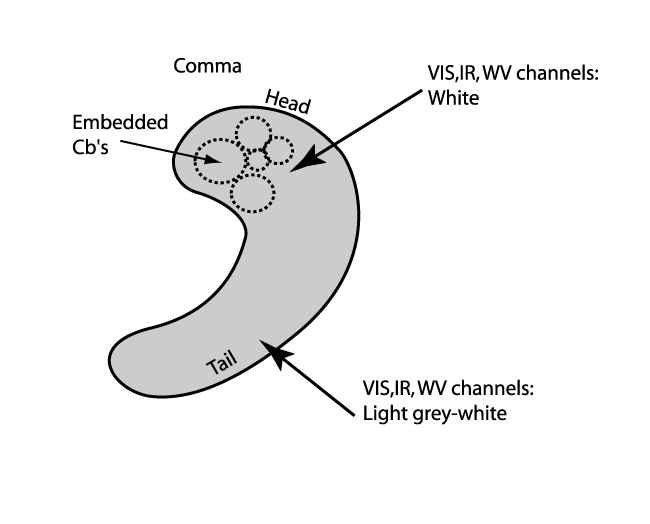 |
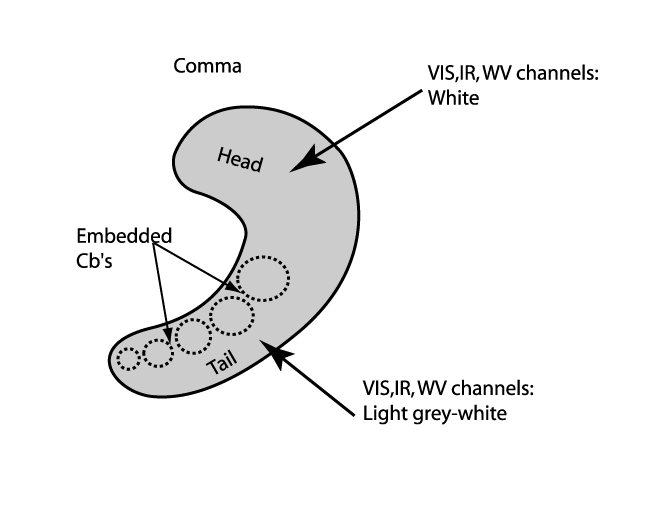 |
Appearance in the basic RGBs:
Airmass RGB:
A comma is a mesoscale cloud feature in the cold air outbreak behind a front; consequently, and unlike for other cloud configuration types, shows the Airmass RGB shows dark blue and brown colours, representing the cold and dry air mass within the comma is located. Very often the brownish colours appear behind the comma and penetrating the comma tail. The area between the comma and the previous frontal cloud band is either blue or brown, depending on the specific case.
The Comma cloud itself looks very similar to that in the IR image but, mostly overlaid by the brownish colour representing the dry air, adding a brownish shade to the bright white colours. This is especially true for the comma tail, which consists of lower cloud.
Dust RGB:
Unlike for other cloud configuration types, the Dust RGB shows blue or pinkish blue colours, representing cloud-free areas. Very often there is low cloud, which shows up as ochre colours.
The comma cloud consists of the dark red areas, representing the thicker and convective cloud parts; this very often includes the comma tail but there are also cases with lower cloud in the comma tail represented by ochre colours.
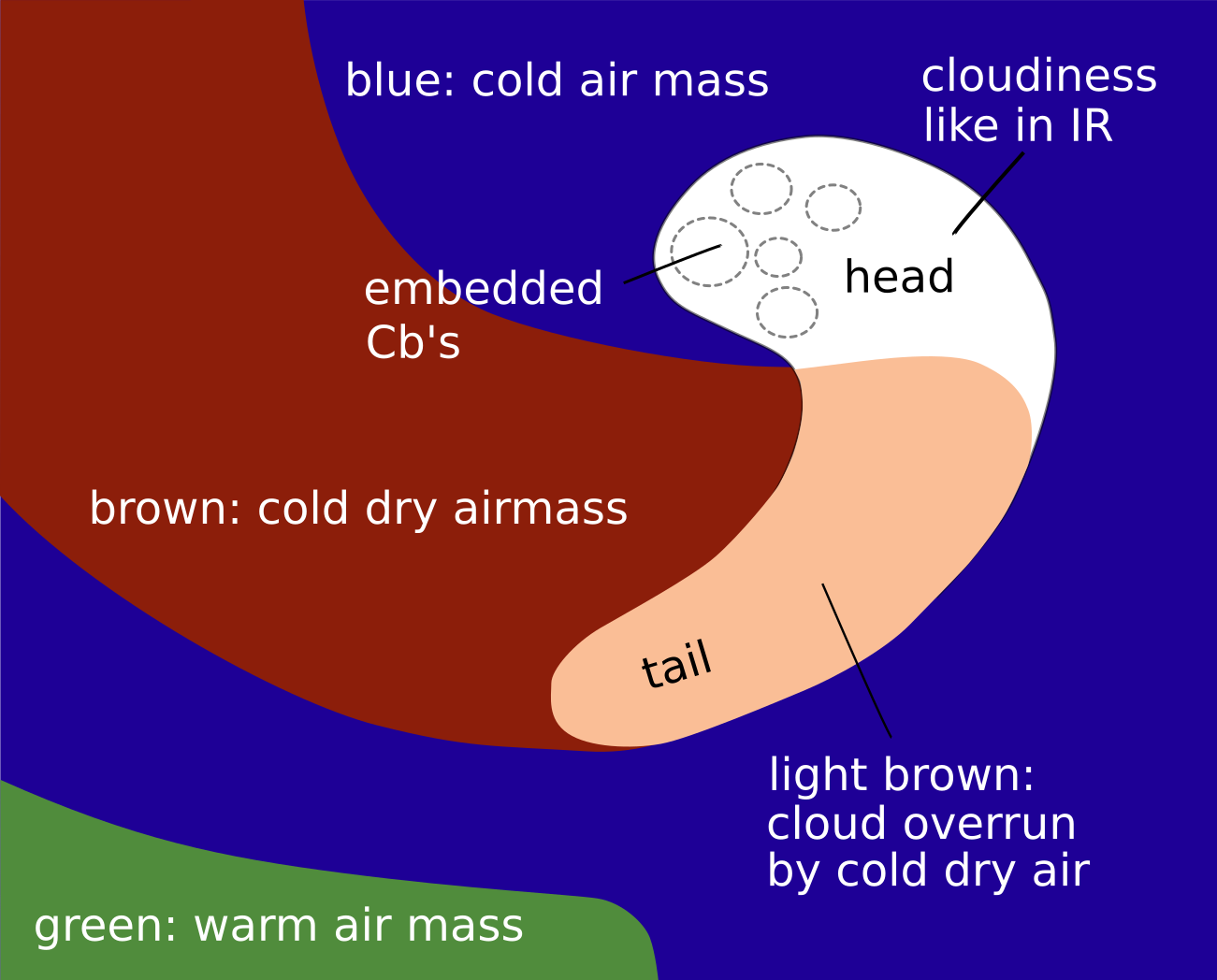 |
|
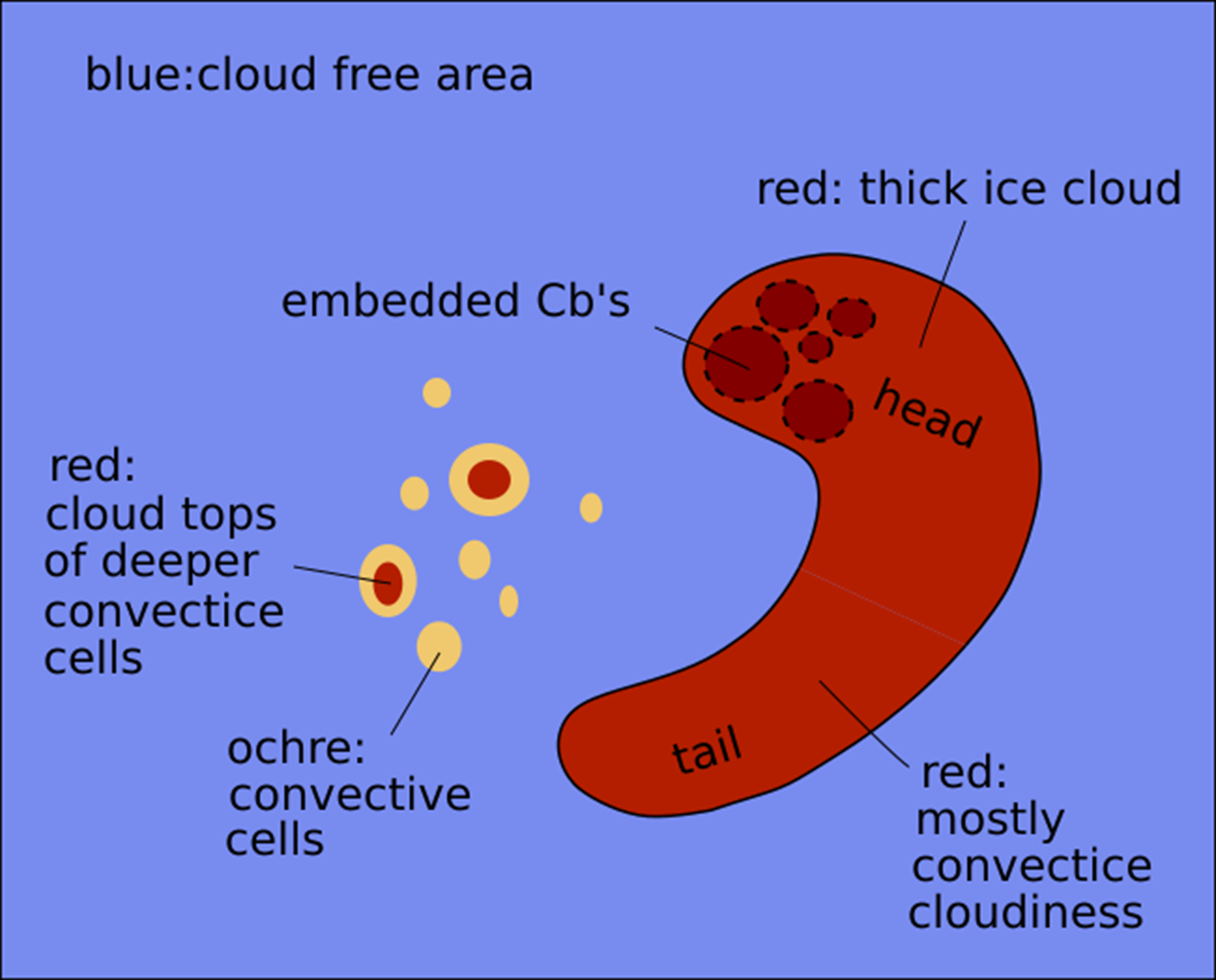 |
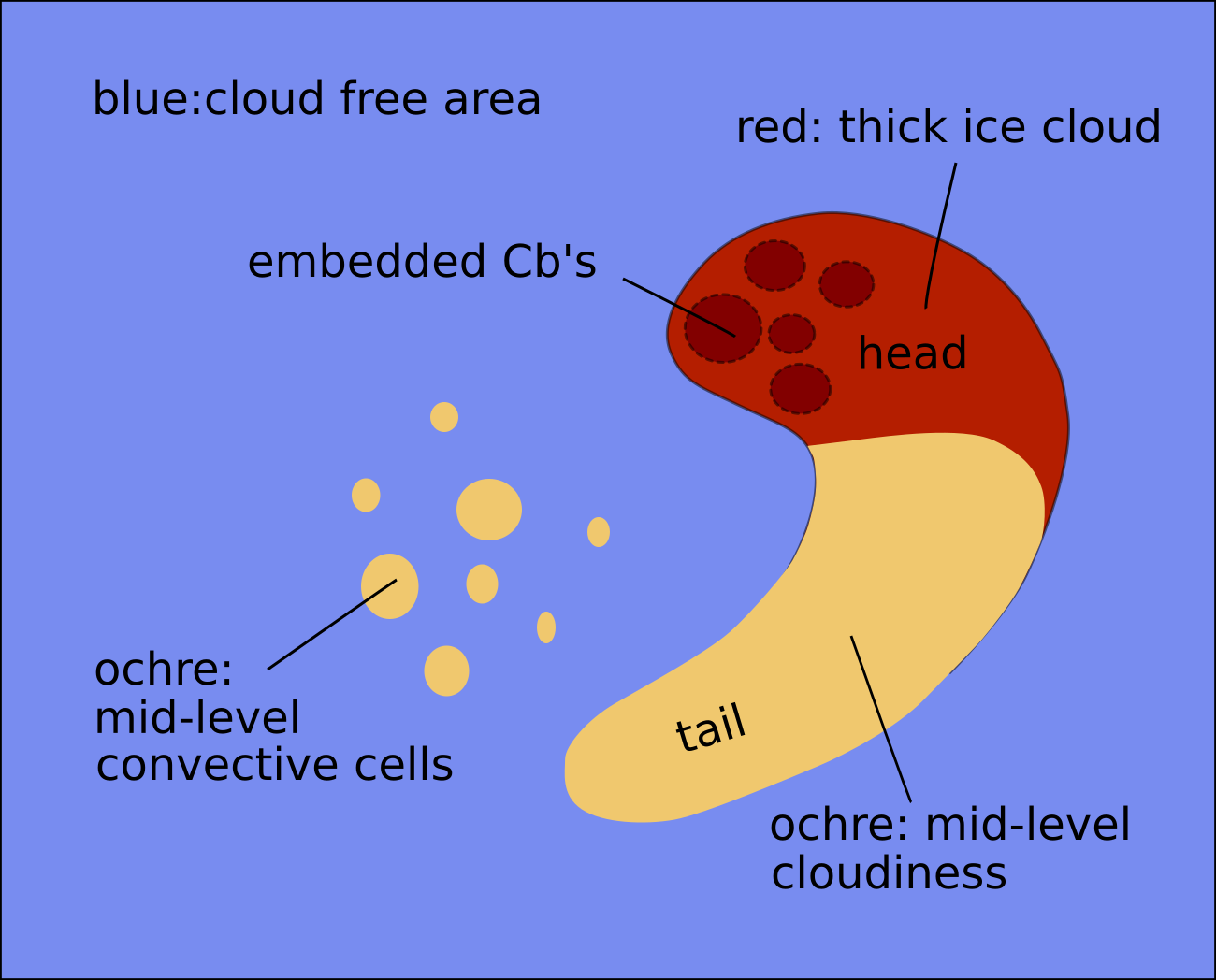 |
Basic RGBs schematics. U. row: Airmass RGB
l.l.: Dust RGB for comma with thick cloud in head and tail; l.r.: Dust RGB for comma with lower cloud in the tail.
Data from 9 November 2019 at 12 show a mesoscale cloud spiral over northern Tunisia and the adjacent Mediterranean Sea.
|
|
|
|
|
| IR | White with embedded Cbs in head and tail; grey areas at the leading part of the comma tail. |
| HRV | White with embedded Cbs; in comma tail only the Cbs are visible. |
| WV | Light grey with a dark stripe on the rear side approaching from the north. |
| Airmass RGB | Dark brown representing dry air to the front and rear of the comma; comma cloudiness is similar to IR but with a brownish "shade" indicating overflowing dry air. |
| Dust RGB | Dark red in the biggest part of the comma representing thick ice cloud; rather ochre colours in some parts of the comma tail representing mid-level water cloud. |
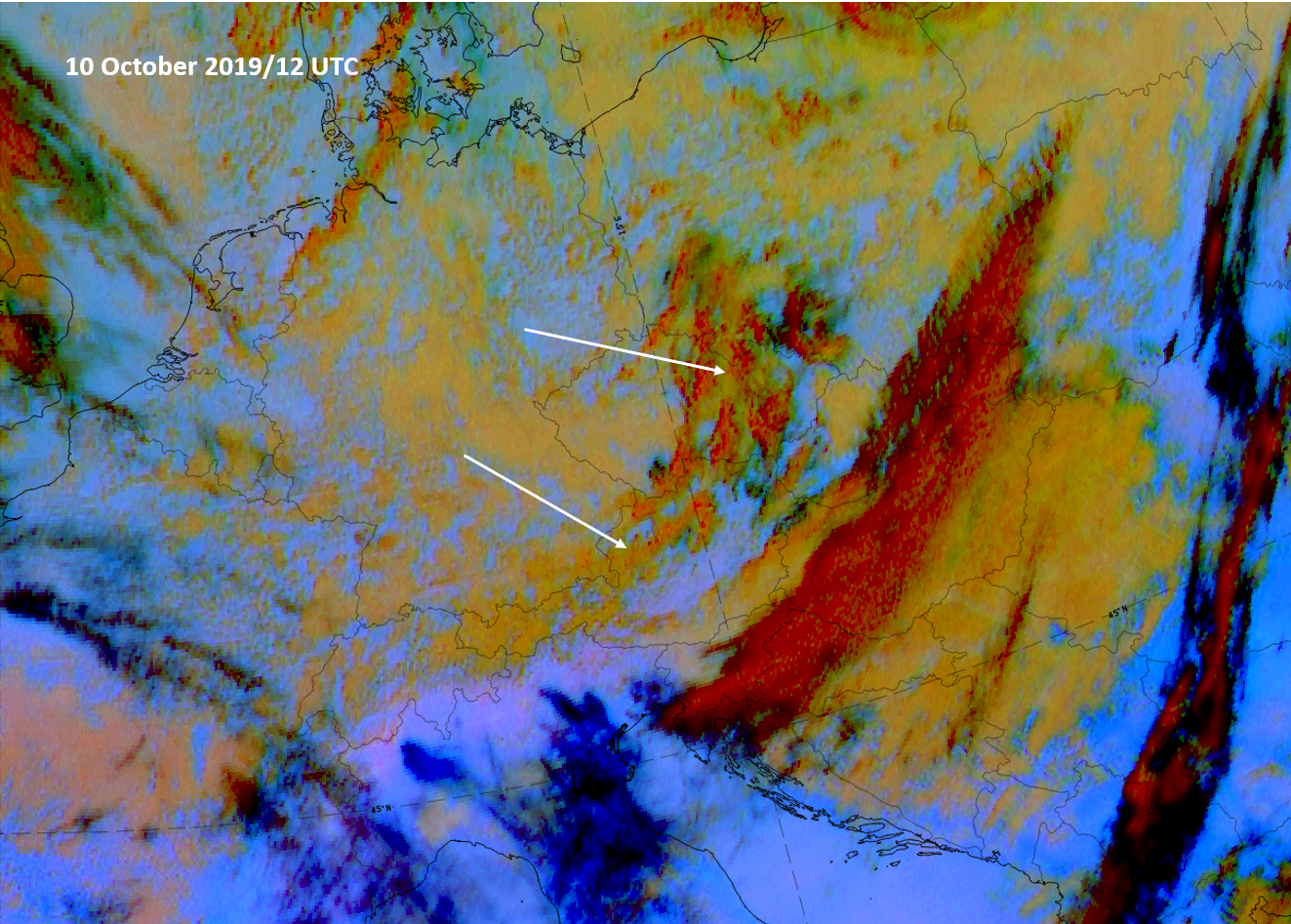 |
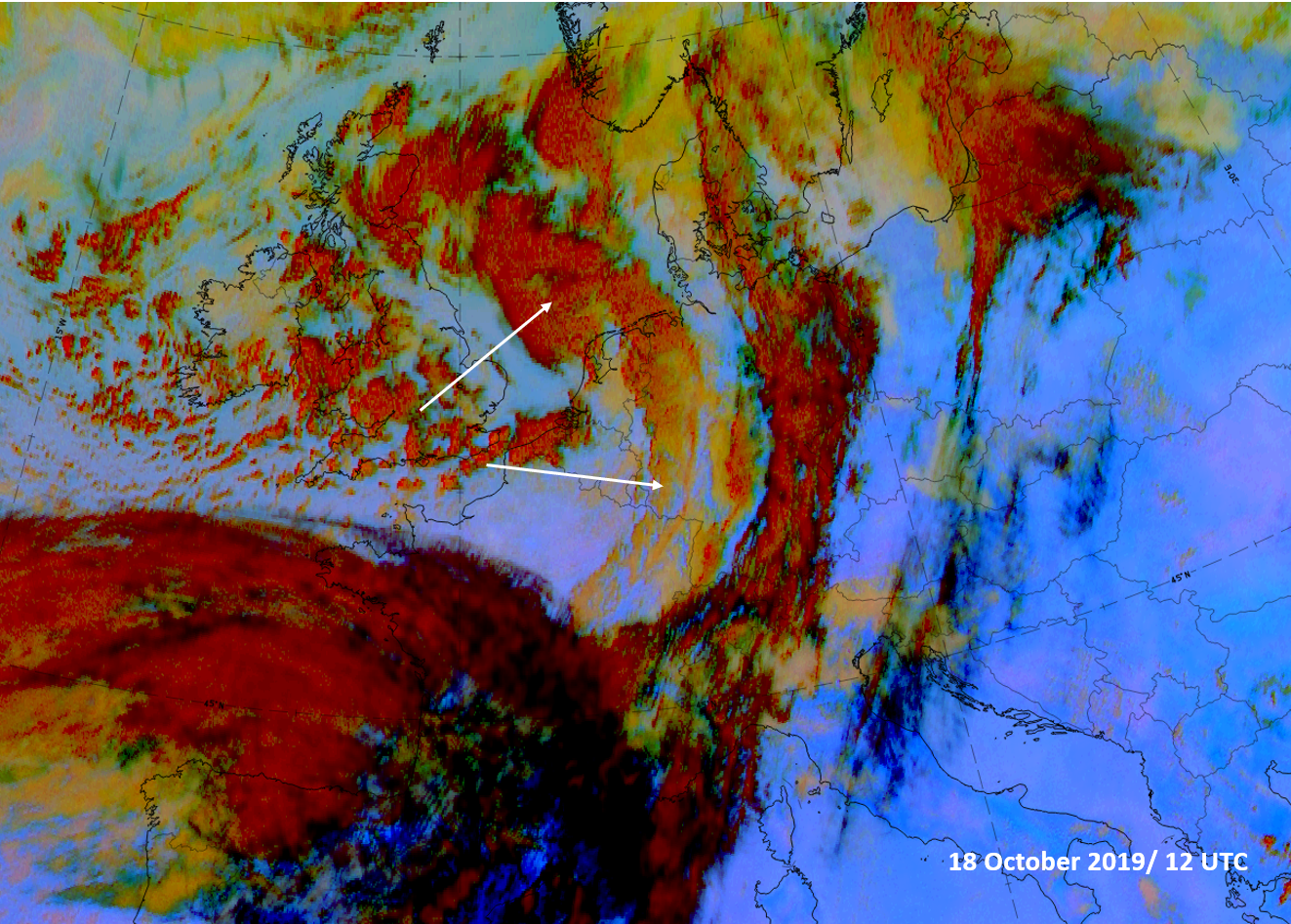 |
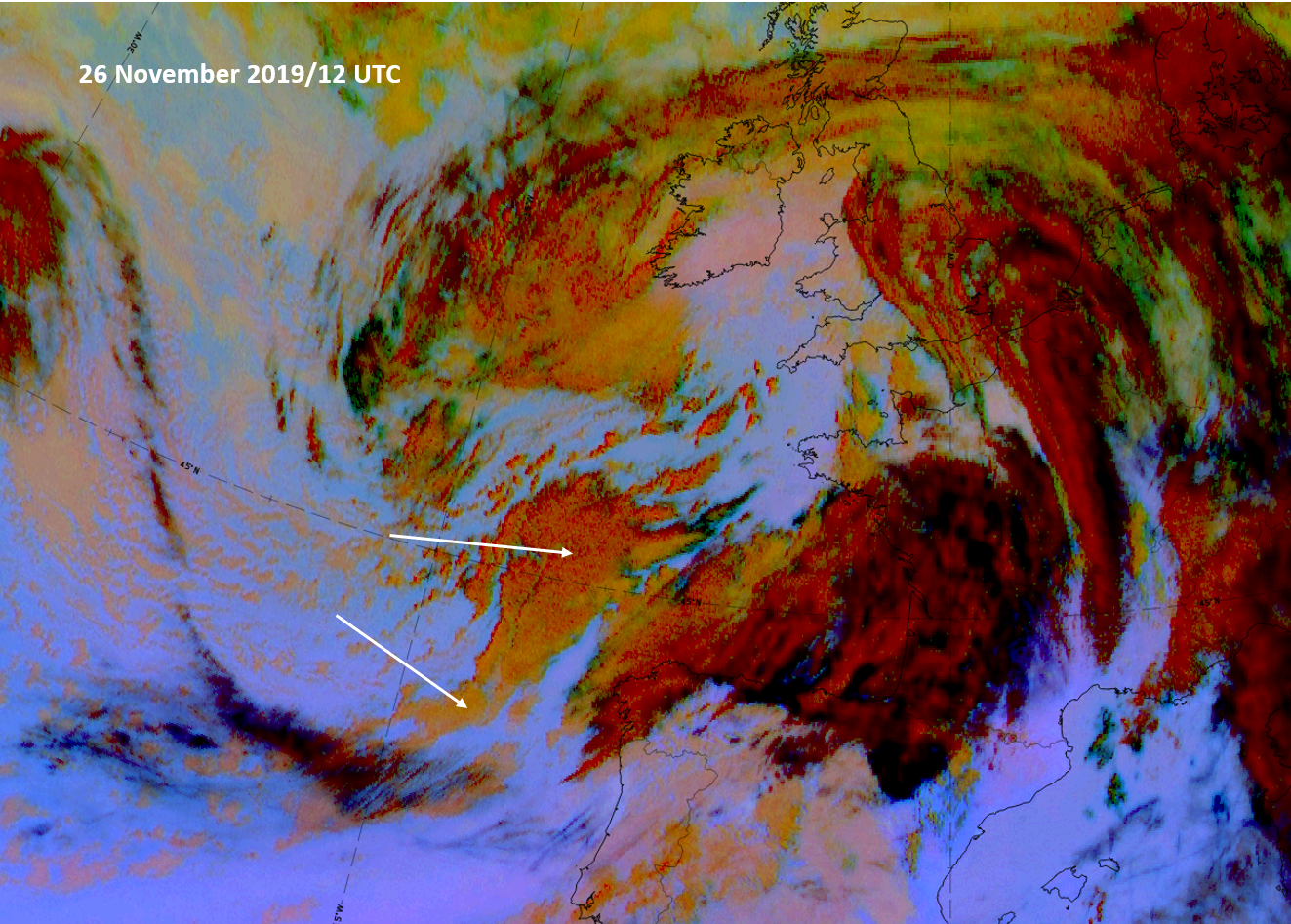 |
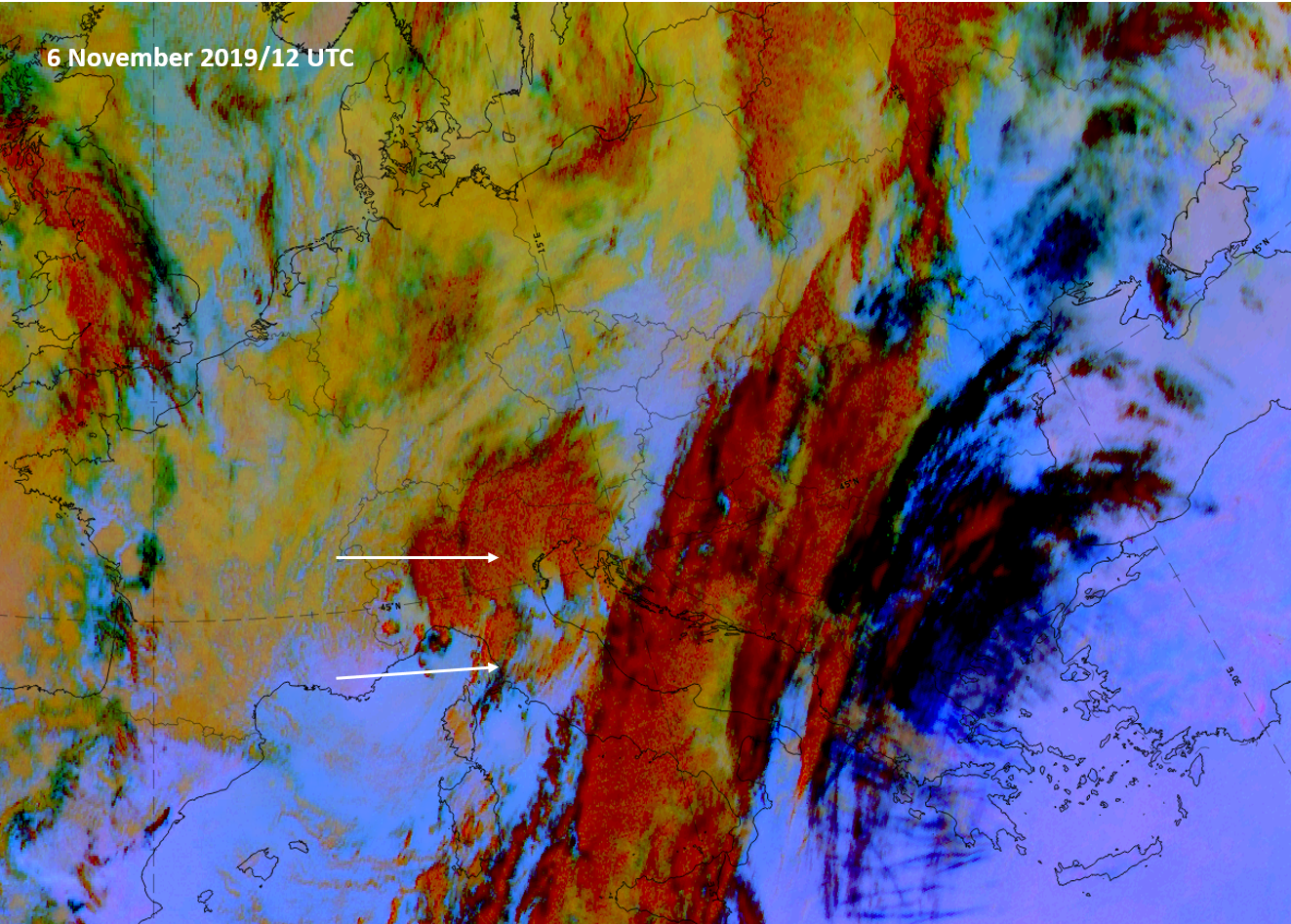 |
Examples of 4 different comma types; Dust RGB.
*Note: click on the image to access the image gallery (navigate using arrows on keyboard)
As mentioned in the introduction of this chapter, commas show a large variety of different configurations and structures; above are some examples which illustrate this. The case on 10th October (u.l.) forms a cyclonic spiral but consists of rather weak cloud with some small cells in the comma head and mid-level cloud in the comma tail. The case of 18 October (u.r.) is the opposite of this, showing a comma head with extended thick ice cloud on a scale already close to that of a fully developed stage of a "cold air development". The well-defined cloud spiral from 26 November (l.l.) on the cyclonic side of the jet axis (black cloud stripe) also shows the differentiation between a comma head under thick cloud and a cloud comma tail consisting of mid-level cloud while, in contrast to this, the case on 6 November (l.r.) shows developing and thick cells also in the comma tail, over Italy.
Meteorological Physical Background
Commas are quite frequent phenomena and whilst they can occur during the whole year they are slightly more common in winter time. Commas are often found over the Atlantic and Western Europe, but are rare in Central and Eastern Europe as they tend to weaken and dissolve over the continent. The usual areas for the development of Commas are higher latitudes which are also typical areas for the development of polar lows. Commas have also been observed on several occasions in the Mediterranean.
The typical horizontal scale of Commas is 200 to 1000 km and their duration can range from several hours to two days.
Here are different types of Comma development:
- Within cold air either
- as further development of Enhanced Cumulus cloudiness or
- as Polar Lows
- As a cut off from a mature and well developed Occlusion spiral
- There are a few other developments from Cold Air Development (CAD) and Baroclinic Boundaries. They are regarded as exceptions and are not addressed further here.
Development of Commas within cold air
The classical development within cold air masses is the most common. A typical life cycle is shown below using a sequence of satellite images (interval one hour).
The development starts from Enhanced Cumulus cloudiness (see Enhanced Cumulus ) which is increasing and, under the influence of vorticity, and finally forms into the typical Comma spiral shape with a Comma head and a Comma tail. This happens mostly in the cold air behind a frontal cloud band under the influence of vorticity and positive vorticity advection.
A maximum of CVA is connected with upward motion in the preferred areas in front of an upper level trough (curvature vorticity) and in the left exit region of a jet streak (shear vorticity)
|
25 April 2005/00.00 UTC - Meteosat 8 IR 10.8 image; red: vorticity advection 500 hPa
|
25 April 2005/03.00 UTC - Meteosat 8 IR 10.8 image
|
|
25 April 2005/06.00 UTC - Meteosat 8 IR 10.8 image
|
|
There are different theories relating to the forcing mechanisms leading to Comma development.
Baroclinic instability
One theory focuses on baroclinic instability. Although baroclinic instability is regarded as a larger scale phenomenon, it can also be used for explaining smaller systems.
Baroclinic waves with a wave length of about 3000 to 4000 km usually show a rapid rate of growth. If parameters such as vertical wind shear (large horizontal temperature gradient) and static stability are taken into account, disturbances with much shorter wave length can also grow rapidly if a jet streak is involved. (For more details see Reed, 1979)
Many case studies of Commas made at ZAMG (more than 50) showed baroclinity at high levels which would support this theory. One example is shown below.
|
25 April 2005/06.00 UTC - Meteosat 8 IR 10.8 image; position of vertical cross section indicated
|
25 April 2005/06.00 UTC - Vertical cross section; black: isentropes (ThetaE), blue: relative humidity, orange thin: IR pixel
values, orange thick: WV pixel values
|
The image shows a Comma feature extending west of Ireland, 53N25W. In the vertical cross section (right) a frontal zone at middle levels (500 - 700 hPa) can be detected.
Barotropic instability
Barotropic instability should also be taken into account when considering a Comma formation. Commas develop on the left side of the polar jet axis. The problem with this theory is the scale: The wavelength of maximum instability is about four times the half-width of the jet. If a Comma (Polar Low) is assumed to have a wavelength of 1000 km the jet would not normally be broader than 250 km in half-width, which is unrealistically small. (For more details see Reed, 1979).
Case studies found in the literature, as well as the ones studied at ZAMG, support this theory with respect to the location of the Comma on the left (cyclonic) side of the jet.
So both theories can explain some features of Comma development but are not totally satisfactory.
CISK mechanism
Another theory is Conditional Instability of the Second Kind (CISK) which focuses on the unstable convective characteristic of the Comma phenomenon. The underlying assumption of this theory states that cumulonimbus convection alone cannot maintain the low-level convergence necessary for the development of clouds. Therefore large scale convergence is also essential. If an air parcel rises in a conditionally unstable, unsaturated air mass, it will give rise to cumulonimbus convection because of the release of latent heat. The vertical distribution of the wind field (low level convergence and high level divergence) results in a convergence of moisture in the boundary layer and an increase of cyclonic vorticity. As a consequence vertical velocity will increase at the top of the Ekman layer. Now a positive feed-back loop is established which amplifies convection as well as the large-scale convergence. This theory was developed for tropical cyclones as the atmosphere normally is (conditionally) unstable at lower latitudes. In several aspects this process is also true for other regions, e.g. if cold polar air streams over a relative warm sea surface.
This theory is supported by those cases where a Comma develops from an EC area far behind the frontal cloud band.
Potential vorticity
Another interesting point of view is the role of potential vorticity (PV). If there is an upper tropospheric PV maximum rising motion occurs at the leading edge - assuming the PV maximum is sinking. There is also a region of reduced static stability there. If a major incursion of high PV overruns a region of moist air and strong baroclinity it leads to cyclogenesis, especially if the induced upward motion ahead of the PV anomaly becomes moist and diabatic effects are involved. (For more details see Browning, 1993)
This theory is supported in the case studies by the fact that a very large number of Commas are associated with a PV anomaly, represented by a very low height of the PV=2 surface, which corresponds to the transition between tropospheric and stratospheric air.
|
07 December 2004/18.00 UTC - Meteosat 8 IR 10.8 image; magenta: Height of PV=2 units
|
|
The case from 07 December 2004 shows a lowering of the tropopause just behind the Comma to around 500 hPa. In the Comma itself a relatively high tropopause can be found.
Further development
Commas, once developed, can be involved in or can be the starting point of other conceptual models such as Instant Occlusion (see Instant Occlusion ) or Cold Air Development (see Cold Air Development ).
Development of Commas from Occlusion spirals
If an Occlusion is accompanied by a very intensive, pronounced cloud spiral the innermost part can become separated, i.e. the connection between the Occlusion spiral and the rest of the cloud spiral becomes an area of only shallow cloudiness and finally disappears so that the remaining Comma cloud becomes a separate feature. Sometimes the innermost part of the Occlusion cloud band disappears and a Comma develops in the cloud-free area. Nevertheless its origin is the Occlusion spiral.
The area where this separation happens is the north-western part of the Occlusion cloud band which disappears as a result of negative vorticity advection and divergence in lower levels. This happens to the rear of the upper level low or trough. In contrast, the innermost part of the Occlusion cloud spiral lies in an area with positive vorticity advection and sometimes within an area of convective activity. Therefore, this is an area where cloudiness can become enhanced.
A Comma which is generated by an Occlusion is shown by the following sequence of satellite images (interval six hours). Such a development is less frequent than the development of Commas within cold air mentioned above.
|
07 December 2004/06.00 UTC - Meteosat 8 WV 6.2 image
|
07 December 2004/12.00 UTC - Meteosat 8 WV 6.2 image
|
|
07 December 2004/18.00 UTC - Meteosat 8 WV 6.2 image
|
08 December 2004/00.00 UTC - Meteosat 8 WV 6.2 image
|
Relative streams and Commas
From the viewpoint of conveyor belt theory, Commas usually lie within one single air mass, the dry intrusion.
Relative streams related to Commas show a characteristic pattern, namely, an isolated cyclonic circulation around the cloud spiral with upward motion within the cloudiness and descending motion behind. This circulation can be observed at all levels above the unstable air mass, up to the tropopause and does not change much between different levels. Only vertical motion is decreasing with height. In the case of Commas without specific circulation, a pronounced cyclonic curvature of the streamlines can usually be found.
|
29 March 1999/06.00 UTC - Meteosat IR image; magenta: relative streams 282K - system velocity: 247° 16 m/s, yellow: isobars
282K
|
29 March 1999/06.00 UTC - Meteosat IR image; magenta: relative streams 300K - system velocity: 247° 16 m/s, yellow: isobars
300K
|
Key Parameters
- Height Contours 500 and 1000 hPa:
show a marked trough, sometimes even an isolated low. The Comma is situated at the leading edge of or near the trough line. Commas are situated at the cyclonic side of the polar jet. There may also be a left exit region of a jet streak (see below). - Temperature advection:
Since Commas are cold air features they are mainly situated in cold advection. Commas which are also partly in Warm Advection have higher baroclinic instability and show a higher probability for further development into Instant Occlusion and Cold Air Development (see Instant Occlusion and Cold Air Development ) - Instability indices:
Commas are characterised by a rather unstable air mass. The typical range of the Showalter index with Commas is 0 to (max) 9, but mostly around 3. But strong instability is rarely seen in the Showalter field even though there can be heavy precipitation. The unstable air mass extends from the surface to about 800 - 700 hPa (see Typical appearance in vertical cross sections), a layer which is probably too low to be fully resolved by the Showalter index (which starts at 850 hPa). The Boyden index shows values that exceed 95. - Relative vorticity at 500 hPa:
is always positive, i.e. cyclonic. The maximum can be found to the rear of the cloud spiral. Both components (curvature and shear vorticity) are positive. Curvature vorticity dominates in the majority of cases, but shear vorticity is also important, especially at 300 hPa and if the Comma is situated in the left exit region of a jet streak (see further below). - PVA at 500 hPa:
has its maximum above the Comma cloud or sometimes shifted to the south. At a level of 300 hPa the maximum is not so pronounced although absolute values are not smaller. There is also a correlation between the two levels: If there is no or only a weak maximum at 500 hPa the probability of a pronounced maximum at 300 hPa is quite small; a left exit region of a jet streak can lead to higher values at 300 hPa. - Isotachs at 300 hPa:
Cyclonic vorticity and PVA at 300 hPa can also be the reason for the position of a Comma in a left exit region of a jet streak. But, in these situations shear vorticity dominates curvature vorticity and the Comma spiral structures are rather weak. - Potential vorticity:
The height of PV=2 units shows a maximum to the rear of the cloud spiral which is equivalent to a lowering of the tropopause there to around 400 hPa. This is significantly lower than at the corresponding frontal cloud bands. Behind a Cold Front a low height of the PV can be observed in a rather large area parallel to the front, but for the Comma a characteristic maximum can be observed (lowest level in the troposphere).
Height Contours 1000 hPa/Surface Pressure
|
|
25 April 2005/00.00 UTC - Meteosat 8 IR 10.8 image; magenta: height contours 1000 hPa
|
Height Contours 500 hPa/Surface Pressure
|
|
25 April 2005/00.00 UTC - Meteosat 8 IR 10.8 image; magenta: height contours 500 hPa
|
Temperature Advection
|
|
25 April 2005/00.00 UTC - Meteosat 8 IR 10.8 image; red: Temperature Advection 1000-500 hPa
|
Boyden Index
|
|
25 April 2005/00.00 UTC - Meteosat 8 IR 10.8 image; red: Boyden Index
|
Relative Vorticity 500 hPa
|
|
24 April 2005/18.00 UTC - Meteosat 8 IR 10.8 image; cyan: relative vorticity 500 hPa
|
Positive Vorticity Advection 500 hPa
|
|
25 April 2005/00.00 UTC - Meteosat 8 IR 10.8 image; red: positive vorticity advection 500 hPa
|
Isotachs 300 hPa
|
|
24 April 2005/18.00 UTC - Meteosat 8 IR 10.8 image; yellow: Isotachs 300 hPa
|
Height of PV=2 units/Height of tropopause
|
|
25 April 2005/00.00 UTC - Meteosat 8 IR 10.8 image; magenta: Height of PV=2 units
|
Typical Appearance In Vertical Cross Sections
- ThetaW:
One of the most characteristic properties of Commas is the instability in lower and middle levels. The unstable air mass is indicated by the distribution of the isentropes up to 800 - 700 hPa. In most cases no frontal character can be seen in the lower troposphere, but in upper levels (above 500 or 600 hPa) sometimes one can see a downward inclination of the isentropes leading to a higher gradient. The peak belonging to the Comma feature under consideration is the one in the right half of the cross section (52.5N/24W). The more western peaks belong to convective areas in the centre of the Comma spiral. - Relative Vorticity:
Commas exist in areas of positive relative vorticity throughout the whole vertical cross section. The maximum lies to the rear at about 400 hPa (never below 500 hPa and not higher than 300 hPa). - Vorticity Advection (PVA/NVA):
Vertical cross sections show PVA above the cloudy area with its maximum in the upper troposphere, in advance of the corresponding vorticity maximum. There can be both PVA and NVA behind and in front of the Comma. - Omega:
Commas are often associated with upward motion throughout the whole atmosphere. - Temperature Advection:
The profile of temperature advection usually shows cold advection in the lower levels trough out the whole area of the Comma. In middle and upper-levels some warm advection can be found over the cloudy area, and cold advection behind the Comma. - Divergence:
The vertical distribution of divergence shows convergence in lower levels often decreasing with height; that can result in divergence in upper levels. This is consistent with upwards motion (see above). Convergence is generally found near the cloudy area but may sometimes be present in the surrounding areas. Convergence is occurring in this case in a thick layer from the surface up to 700 hPa.
As shown below the appearance of a Comma in a vertical cross section is best described by a cross section taken south of the Comma head.
|
25 April 2005/06.00 UTC - Meteosat 8 IR 10.8 image; position of vertical cross section indicated
|
|
ThetaW
|
|
25 April 2005/06.00 UTC - Vertical cross section; black: isentropes (ThetaE), orange thin: IR pixel values, orange thick: WV pixel
values
|
Relative Vorticity
|
|
25 April 2005/06.00 UTC - Vertical cross section; black: isentropes (ThetaE), blue: relative vorticity, orange thin: IR pixel
values, orange thick: WV pixel values
|
Vorticity Advection (PVA/NVA)
|
|
25 April 2005/06.00 UTC - Vertical cross section; black: isentropes (ThetaE), green thick: vorticity advection - PVA, green thin:
vorticity advection - NVA, orange thin: IR pixel values, orange thick: WV pixel values
|
Vertical Motion (Omega)
|
|
25 April 2005/06.00 UTC - Vertical cross section; black: isentropes (ThetaE), cyan thick: vertical motion (omega) - upward motion,
cyan thin: vertical motion (omega) - downward motion, orange thin: IR pixel values, orange thick: WV pixel values
|
Temperature Advection
|
|
25 April 2005/06.00 UTC - Vertical cross section; black: isentropes (ThetaE), red thick: temperature advection - WA, red thin:
temperature advection - CA, orange thin: IR pixel values, orange thick: WV pixel values
|
Divergence
|
|
25 April 2005/06.00 UTC - Vertical cross section; black: isentropes (ThetaE), magenta thin: divergence, magenta thick: convergence,
orange thin: IR pixel values, orange thick: WV pixel values
|
Weather Events
Commas can be split into a head and a tail, whereby the head clouds are layered, with dynamical precipitation and the tail clouds are more convective, with showery precipitation.
| Parameter | Description |
| Precipitation (incl. thunder) |
|
| Temperature |
|
| Wind (incl. gusts) |
|
| Other relevant information |
|
These features are best illustrated using data from 18 October 2019 at 12 UTC, when a huge comma occurred, with its head over the North Sea and its tail extending from the Netherlands into France. The comma head shows with the dark red colour thick ice cloud with a lumpy structure in dark red, while the tail consists mostly of mid-level cloud represented by the ochre colours.
18 October 2019,12 UTC; Dust RGB.
|
|
18 October 2019, 12UTC: IR + synoptic measurements (above) + probability of moderate rain (Precipitting clouds PC - NWCSAF).
Note: for a larger SYNOP image click this link.
There where wide-spread precipitation reports based on the synoptic measurements, with more intensity in the comma head than in the comma tail. The probabilities of precipitation from the NWCSAF show values of more than 55-65 % represented by orange and red colours in parts of the comma head.
|
|
|
|
18 October 2019, 12 UTC, IR; superimposed:
1st row: Cloud Type (CT NWCSAF) (above) + Cloud Top Height (CTTH - NWCSAF) (below); 2nd row: Convective Rainfall Rate (CRR NWCSAF) (above) + Radar intensities from Opera radar system (below).
For identifying values for Cloud type (CT), Cloud type height (CTTH), precipitating clouds (PC), and Opera radar for any pixel in the images look into the legends. (link)
References
General Meteorology and Basics
- FORBES, LOTTES (1985): Classification of Mesoscale Vortices in Polar Airstreams and the Influence of the Large-scale Environment on their Evolutions, Tellus, 37A, 132 - 155
- RASMUSSEN (1979): The Polar Low as an Extratropical CISK Disturbance, Quart. J. Royal Meteor. Soc., 105, 531-549
- REED (1979): Cyclogenesis in Polar Air Streams, Monthly Weather Review, 107, 38-52
- TURNER, LACHLAN-COPE, THOMAS (1993): A Comparison of Arctic and Antarctic Mesoscale Vortices, J. Geophysical Research, 98, D7, 13019-13034
General Satellite Meteorology
- CARLETON, CARPENTER (1989): Satellite climatology of Polar Lows and Broadscale Climatic Associations for the Southern Hemisphere, Int. J. Climatology, 10 (3), 219-246
- CLAUD ET AL (1993): Satellite Observations of a Polar Low over the Norwegian Sea by Special Sensor Microwave Imager, Geosat, and TIOS-N Operational Vertical Sounder, J. Geophysical Research, 98, C8, 14487-14506
Specific Satellite Meteorology
- BROWNING (1993): Evolution of a Mesoscale Upper Tropospheric Vorticity Maximum and Comma Cloud from a Cloud-free Two-dimensional Potential Vorticity Anomaly, Quar. J. Meteor. Soc., 119, 513, 883-906
- CRAIG (1992): A Study of Two Cases of Comma-Cloud Cyclogenesis Using a Semigeostrophic Model, Monthly Weather Review, 2942-2961
- REED (1979): A Case study of Comma Cloud Development, Monthly Weather Review, 114, 1681-1695
- REED (1979): A Further Case study of Comma Cloud Development, Monthly Weather Review, 114, 1696 -17
